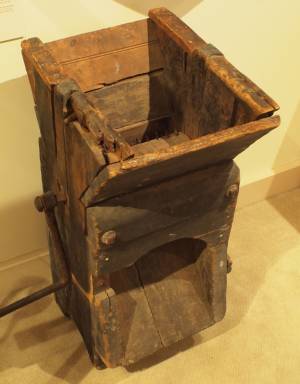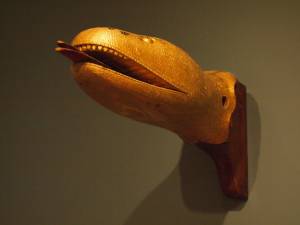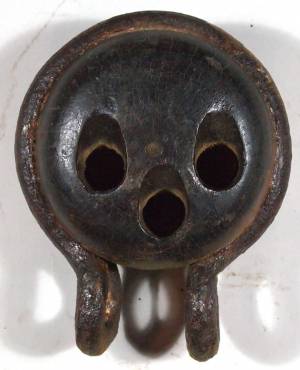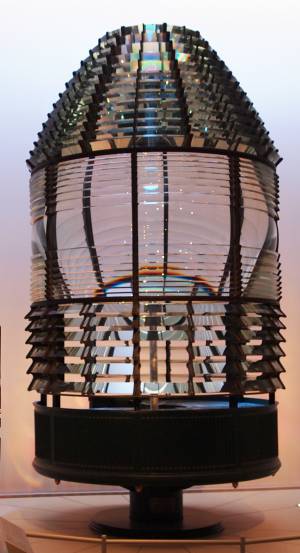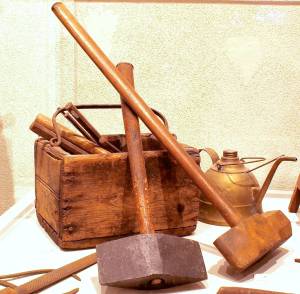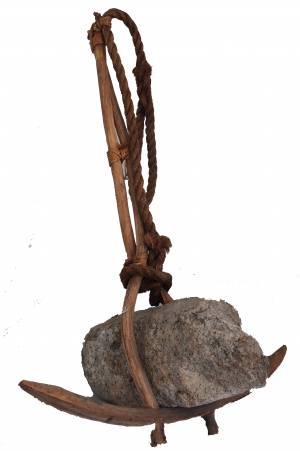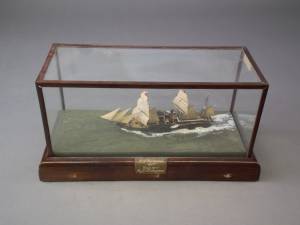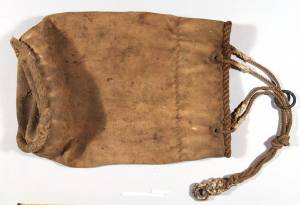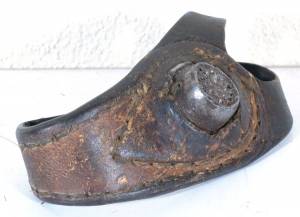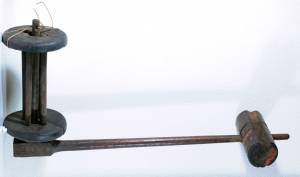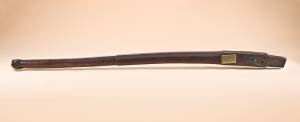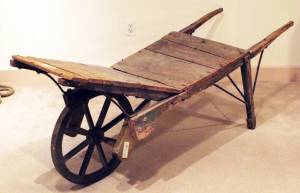An online project under the direction of the CAPE ANN MUSEUM
Historical Materials: 19th-Century Documentation
Historical Materials » 19th-Century Documentation » Objects
Objects
Mid-19th century
Base: 15" square Top: 15" x 19" Height: 36"
Gift of Capt. Ben Pine, 1946
Cape Ann Museum, Accession No. 1157
A hand-powered mill for grinding small bait fish (herring) into small bits called chum, which was kept in a chum box lashed to the side of the schooner amidships, on the starboard side, where the crew fished from the rail. As the mackerel swam under the schooner, chum would be tossed from the box with a large spoon in a process called tolling. If hungry, the mackerel would bite at the chum - and at fishing lines with mackerel jigs - in a feeding frenzy.
E.R.
Also filed under: Mackerel Fishing »
12' 5"l. x 7' I" w. x 4' 9" h.
19th and early 20th c.
Cape Ann Museum. Gift of Thomas A. Robinson, 1983 (2344)
While heavily constructed to transport ballast stone from local beaches, this style of cart was used for many purposes. It is otherwise identical in design to horse-drawn carts depicted in Lane’s paintings.
Carved wood with paint and gilt
12 x 22 x 8 in.
Cape Ann Museum. Gift of George W. Woodbury, 1936 (747)
This sea serpent billet head came from the schooner "Diadem" which was built in Essex, Massachusetts, in 1855 and owned by D. Elwell Woodbury and John H. Welsh of Gloucester.
Sea serpents were reportedly sighted here on Cape Ann from colonial times through the mid-nineteenth century. In 1817, more than 50 people, many of them prominent members of the community, reported seeing a serpent in the waters of Gloucester Harbor just off Pavilion Beach. So credible were the reports that the Linnaean Society of New England collected depositions from witnesses and published their findings in a small pamphlet entitled Report of a Committee of the Linnaean Society of New England relative to a Large Marine Animal Supposed to be A Serpent, seen Near Cape Ann, Massachusetts, in August 1817.
Also filed under: Pavilion (Publick) Beach » // Vessel Details: Decorations / Ship Carvings »
Cape Ann Museum. Gift of Erik A.R. Ronnberg (2507.63)
A deadeye is a round block with scored holes for lanyards used to set tension on shrouds and stays. The upper deadeye is seized into an eye in the shroud or stay. The lower deadeye is fitted with a forged iron strap which is bolted to a chain plate fastened to the ship's hull.
Also filed under: Vessel details: Rigging and Sails »
288 individual prisms are mounted in a brass frame, the whole structure measuring 9 ft. 4 in. high and 6 ft. 5" diameter.
Cape Ann Museum. On permanent loan from the United States Coast Guard, 2013
Installed in south light tower, 1861; removed, 1980.
Also filed under: Rockport, Mass. - Thacher Island Twin Lighthouses »
Wood, wicker, cordage
19 1/2 x 23 in.
Cape Ann Museum (2089-3 G/O EARR)
Used at wharfside for carrying fish and small fishing gear.
View related Fitz Henry Lane catalog entries (4) »
Also filed under: Fishing » // Mackerel Fishing »
Four circular glass prism lenses in a brass frame:
Lens diameters 19". Base 21" square x 19-1/2" high.
Cape Ann Museum. On permanent loan from the United States Coast Guard, 2013
When installed, the light source was fixed and the lens mount rotated.
Also filed under: Gloucester, Mass. – Eastern Point Light »
Painted wood
Scale: 1:16. Galamander shop, Vinalhaven, Maine.
Cape Ann Museum. Gift of Barbara Erkkila, 1997
In the nineteenth century granite was hauled from Cape Ann quarries on heavy carts called garymanders which were pulled by oxen or horses (known as "galamander" in Maine.) A boom rigged above the rear axle was used to hoist the stone so it could be held by chains beneath the wagon. The garymander oak wheels were eight feet high with iron rims made by a blacksmith.
Also filed under: Granite Quarrying / Shipping »
Cape Ann Museum (1994.65)
Oilcan originally owned by Frederickj "Rick" Larsen
Cape Ann Museum (1994.76.3)
Peen hammer originally owned by Johann Jacob Erkkila (1877–1939)
(Cape Ann Museum) 1994.76.23a
Heavy blacksmith's sledge owned by John Fuge (1873–1967)
Cape Ann Museum (1997.24.0)
Although from a later period, these tools are similar to tools used in Lane's time.
Also filed under: Granite Quarrying / Shipping »
Gloucester, MA
4 x 33 1/2 x 7 1/4 in (10.16 x 85.09 x 18.415 cm)
Peabody Essex Museum
Also filed under: Ship Models » // Small Craft – Wherries, and Dories »
Stone, oak wood and twine
Sandy Bay Historical Society and Museum, gift of Jack Lawson (1310)
A type of anchor used in dory fishing.
View related Fitz Henry Lane catalog entries (2) »
Also filed under: Fishing »
Ship model
50'/1"
M15732
Peabody Essex Museum
Also filed under: "Britannia" (Cunard Steamship) »
Cotton fabric, hemp cord, iron draw-ring and thimbles
Cape Ann Museum (2507.62)
Riggers' ditty bags held an assortment of tools and materials for use outside the loft (at wharfside, on board, or aloft). Such items might include fids (for splicing), light cordage for whipping, marline and spunyarn for serving and seizings, needles and thread for canvasing rigging line at fraying surfaces. The items were selected according to anticipated tasks.
– Erik Ronnberg, as explained by Erik Ronnberg, Sr.
Also filed under: Vessel details: Rigging and Sails »
Leather, rawhide, and steel
Cape Ann Museum (2726.2)
Worn on the hand to protect the palm when pushing a needle through tight-woven sailcloth. The eye of the needle sits in one of the dimples in the steel plate called the "eye."
Also filed under: Vessel details: Rigging and Sails »
Steel and wood
31 in.
Cape Ann Museum. Gift of Erik A. R. Ronnberg, 1995 (2507.20)
A serving mallet is used to cover natural fiber rope with a wrapping of marline (or spun yarn). This covering would reduce chafe and keep water from getting into the cordage and causing rot. The marline would be applied with tar or tar would be added afterwards. This process would take place either in the rigging loft or on the vessel by a professional rigger.
Wood
105 x 5 x 4 inches (266.7 x 12.7 x 10.16 cm)
Peabody Essex Museum
Tiller used in navigating the yacht "America" across the Atlantic in 1851.
Also filed under: "America" (Schooner Yacht) »
Wood, brass, paint
9 1/2 h. x 11 3/4 diam. inches
Cape Ann Museum. Bequest of Marion Mansfield Patterson Livingston. (2012.27)
Salvaged from the burning wreck of the packet ship Boston which was lost at sea in 1830. This disaster was the subject of Lane’s earliest known watercolor painting.
5' 11" l. x 28" h. x 23" w. Wheel 20" d.
19th–early 20th century
Cape Ann Museum. Gift of the Gloucester Fishermen's Museum (2542)
Used to move salt fish in a flake yard. Barrows of this type were commonly used to carry a wide variety of materials around the waterfront.
View related Fitz Henry Lane catalog entries (1) »
Also filed under: Drying Fish »
